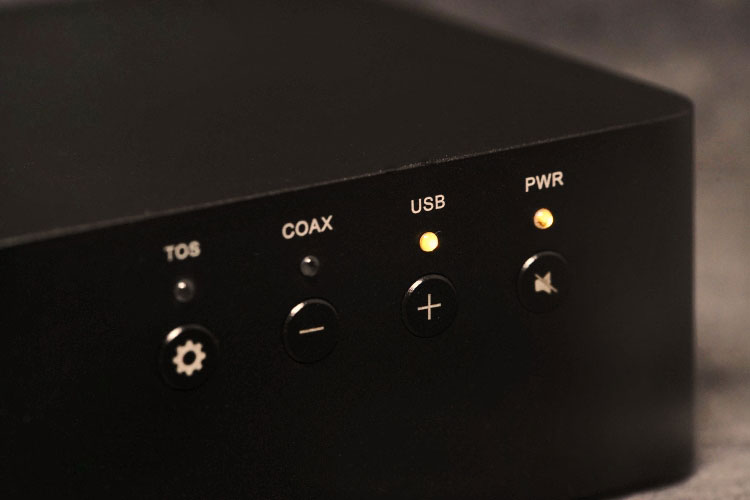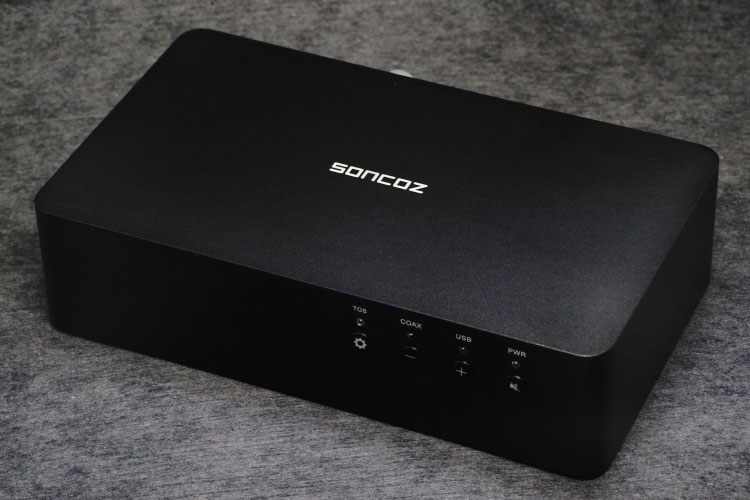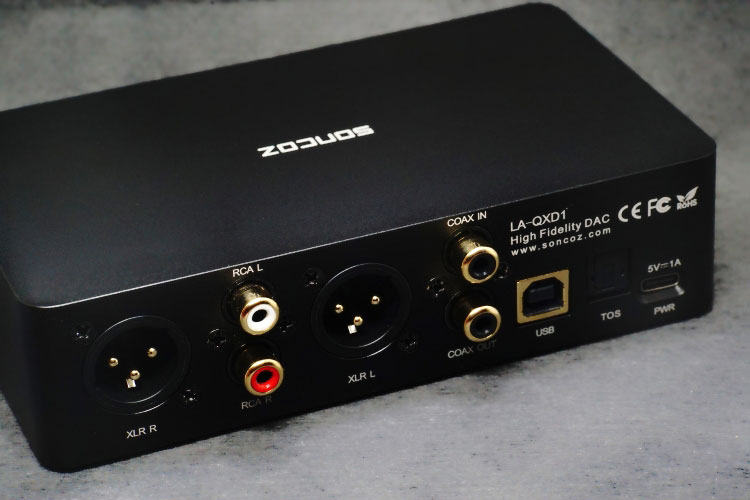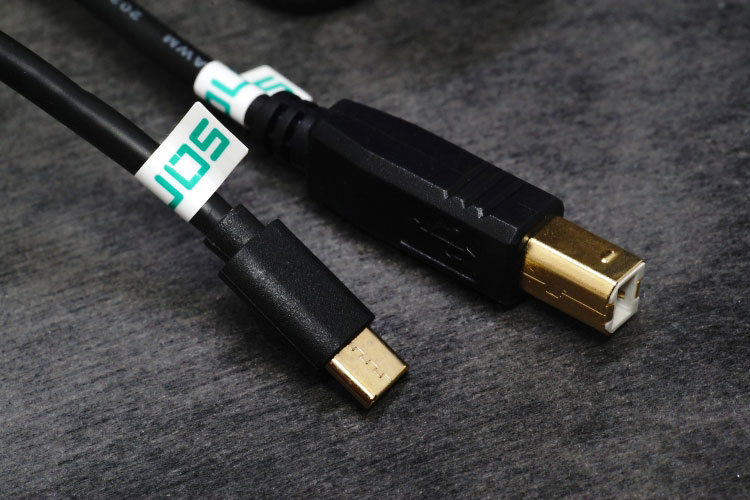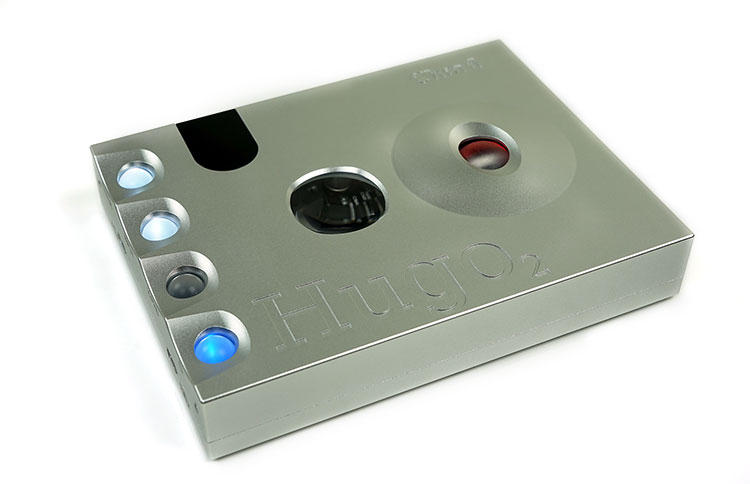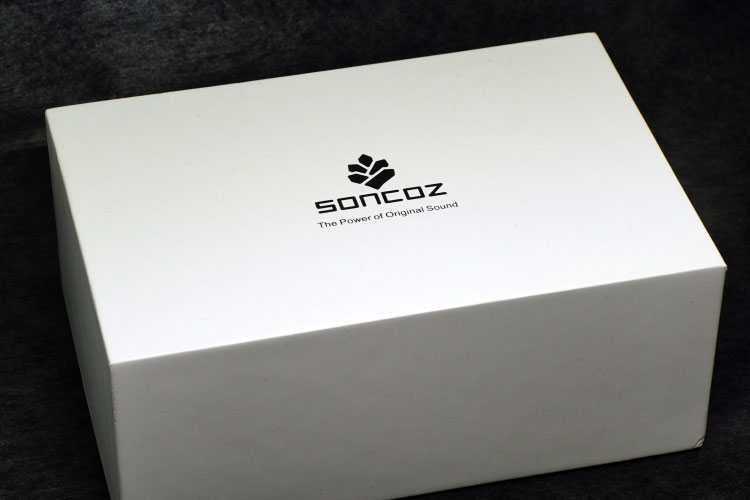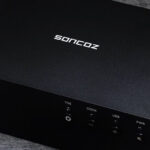The SONCOZ LA-QXD1 is a desktop DAC using an ES9038Q2M and capable of decoding up to DSD512 native and PCM 32BIT/768kHz. It is currently priced at $199.
Disclaimer: The SONCOZ LA-QXD1 sent to us for this review is a sample in exchange for our honest opinion. We thank Soncoz and HiFiGo for giving us this opportunity.
To read more about DAC products we have reviewed on Headfonics click here.
Note, this review follows our new scoring guidelines for 2020 which you can read up on here.
We have been covering a lot of amps and dongles recently, and this time on our desk sits something different. The Soncoz LA-QXD1, a small balanced decoder with perfect aesthetics for desktop decoding has recently impacted the market with its stunning specs and clean design, not to forget a very welcoming asking price!
The LA-QXD1 has scored some amazing measurements online so I thought it has to be worth a review. I am quite surprised it actually has a petite form factor, very space-friendly if your amplifier is already taking so much room.
Aside from the compactness, the specs seem excellent. However, does it sound good and connect flawlessly with different gears? Time to hook it up to the gears to see how it fairs!
Background of Soncoz
The brand Soncoz gets its name from the pronunciation of pinecone in Mandarin. The brand is new yet they have quickly pulled out two models. The higher-end, Bluetooth & screen-equipped SGD1 is their TOTL DAC, and our current review sample, the more compact and budget-friendly LA-QXD1.
These competitively priced DACs have successfully drawn good interest from many prosumers who demand serious specs, and the brand has gained good word of mouth through continuous updates on the software.
Tech Inside
The LA-QXD1 is a dedicated balanced desktop DAC using an ES9038Q2M chipset and is built for one single purpose, to beat your all-in-one decoding offering better dynamic range, noise/ distortion control, and filtering options to smoothen the sound to your preference.
The LA-QXD1 supports a modern PCM 32BIT/768kHz and native DSD512 decoding capability and will interface directly with Macs with PCs requiring drivers from Soncoz’s website.
Balanced connections, as well as normal RCA outputs, are offered including traditional USB inputs and optical/Coaxial connections. You can also hook up your Mac, your PC, and DAPs directly using its coaxial input.
Design
The LA-QXD1 comes in a very minimalistic anodized aluminum casing machined by CNC (Computer Numeric Control) processing. The anodized surface treatment feels very smooth to the touch with a premium aesthetic and no sharp edges.
Looking at the bottom of the DAC there are some heat dissipation holes carved out which may point good to possibly less throttling and better performance. All connectors on the back of the DAC are gold plated as well as the supplied power and USB cable.
On the front panel of the LA-QXD1, there are some buttons and LED indicators that show the working status of the DAC. You can switch between inputs, control digital volume output, change digital filters, and mute the device instantly.
The LA-QXD1 USB input is set on default with a starting volume of -60dB so pretty safe to connect directly. Remember to turn your connected amplifier to the lowest volume to avoid any accidental damage to your speakers/ earphones.
You can also press the PWR (power) /MUTE button for 2 seconds to switch between digital filters. The filter options are explained on Soncoz’s website, we will elaborate more below.
I/O
As a pure DAC, the LA-QXD1 needs a separate amplifier to work with unless you have active speakers with a built-in amplifier that supports a direct analog connection.
The LA-QXD1 also integrates USB-B, Optical, and RCA Coaxial digital inputs. LA-QXD1’s analog output interface supports a full balanced XLR connection and a single-ended RCA connection.
From official data, the output amplitude on XLR is standard 4V and 2V on RCA. On the balanced connection, it offers twice the RMS so if you want optimized power, stick with the balanced output.
Power supply
The LA-QXD1 comes with a USB C cable (without a transformer plug) and uses a universal Type-C (5V@1A) interface for power input. Users can choose to use an adapter or a power bank to power the DAC.
I am using the iPhone charger for power supply and it works smoothly enough. Be aware, some USB outlets like the one on your PC panel may not work when current is insufficient to support the load.
I would recommend getting a quality USB transformer for better power quality and stability as is in an always-on mode when plugged in like the Proj-ect Audio Pre-Box S2 Digital.
Packaging and accessories
The LA-QXD1 comes in a plain box, you will find the brand’s sticker, the DAC unit with USB cables for power and signal inside. The cables supplied are quite thick and gold plated.
There is no supplied physical user manual, instead, you will have to download it from their site as well read in more detail about the designs and filtering options available.
Digital filters
There are 7 different digital filters onboard the LA-QXD1, switching between them leads to audible differences. The APOD filter mode is set as default for all inputs and you could switch between APOD, BRIC, FAM, FAL, HYER, SLM, SLL accordingly by pressing & holding the PWR and MUTE buttons.
Soncoz has released a table that you could refer to for the LED status and the relative filter options. From ESS’s datasheet, you could find some trace of what the filters do and their corresponding status shown by LED.
The filters mainly mess with how fast the roll-off is setting in and my personal recommendation is to listen and find the most natural output with your setup and stick with it.
There is no absolute best choice of filters and quite some times the stock filter gives the least roll-off. Some could color the sound with a more limited dynamic range/lean tuning direction. While the filtering effect is more or less subtle all impressions below will be based on the default setting.
Sound Impressions
Truth be told I am not a measuring guy and there are multiple measurements from respectable sources so I will be giving objective comments on the sound.
The very good measurements and specs have suggested top-notch noise control and dynamic range from the LA-QXD1. I can double confirm that when compared to some highly regarded decoders that could cost more fortunes.
As a side note, Soncoz has fixed an early ESS hump issue on the LA-QXD1 and there are firmware updates to keep its performance and stability amazing.
I am running this DAC on my Macbook Pro and Thinkpad, hooking it up to some DAPs as well with their supplied coaxial cables. Short pure silver jumpers are used to minimize the coloration from cables and I have some common RCA cables for tests as well.
There is no issue with any formats on Audirvana/Foobar and it sounds very well textured, handles high volume well with little distortion, and sounds dynamic and extended without failing expectations. The starting volume is safe, with no heart attacks. The device is being run in/ used for a few weeks before impressions are made.
Balanced or Single-ended?
When a balanced connection is possible I would always pick it instead of RCA for better background noise control. The advantage is more obvious when the interconnects get long where RCA may have more noise-induced and XLR cables at much lower price brackets would still work nicely.
Connecting the LA-QXD1 to my balanced amplifiers gives excellent background noise control and distortion is not hearable at my listening volume. It could be my cables but generally, it sounds cleaner with higher vocal pitches, with dynamic range maintained also kicking firmer in the bass.
Select Comparisons
Hiby R6/ M11 Pro Lineout
Many DAPs company are now equipping their machines with USB DAC functions or using coaxial outputs. The FiiO M11Pro, and the Hiby R6 series, (and many more DAPs for that matter), have SPDIF options. Often they come with connector cables for that very purpose to allow you could hook up to a DAC thus turning the DAP into a transport bypassing its in-built DAC and Amplifier.
Once switching to the SPDIF you will probably realize it sounds quite different from the stock sound. Comparing DAP – line out – amplifier against DAP – digital out to Lthe A-QXD1 and upgrading the amplifier results in much better detail retrieval, a more dynamic sound with more perceived control, and refinement.
Quickly A/Bing between portable amplifiers I can confirm the LA-QXD1 sounds as good, if not better than the inbuilt decoding on these mid-tier DAPs. If you have some older DAPs equipped with a coaxial out, you will get some value in using them as a transport with the LA-QXD1 to an amplifier rather than their generally weaker direct LO outputs.
FiiO K5 Pro
Would an integrated DAC Amp like the FiiO K5 Pro be superior and a better value choice? In this case, it is a big yes, even when using the K5 Pro’s own amplifier. The FiiO K5 Pro has an inbuilt decoding chipset from AKM yet it allows RCA input for you to hook up to an external decoder.
The internal DAC Amp is powerful and very functional for its price yet it focuses more on the amplifier circuit than the decoding part. When you hook it up to another external DAC like the LA-AXD1 you will immediately get much better control, bass texture, and a more musical tuning. The onboard decoding option has less resolution, distortion control, and lacking in good mids texture.
I like how the K5 Pro sounds with the LA-QXD1 on the low gain as it sounds more transparent and detailed. This combo looks lovely on the desk with a similar clean and minimalistic theme. With the LA-QXD1 it completes the experience and you can still use the K5 Pro as a preamp with its analog lineout jacks.
Chord Electronics Hugo 2
The Hugo 2 is at a much higher price bracket and since the original Hugo first-gen, there are quite some people using it as the decoder. It has been my daily desktop source since its release and I love how it smoothens up the mid-treble range, giving the treble a lot of air while keeping a lot of information in the mid-bass.
Comparing the LA-QXD1 with Hugo 2 (stock filter) on RCA they definitely do not sound alike. The LA-QXD1 is cleaner, with similar power and response speed in the bass and it sounds rawer in the treble, while the Hugo2 sounds more refined and colored, also better in width.
Keeping in mind the LA-QXD1 is much cheaper it is doing a fantastic job but the Hugo 2 has many more functions and headphone/ IEMs connectivity so I am giving both devices a big thumbs up! Switching the two between different in/outputs there is no glitches or noises, filter options could work for some people but I preferred unaltered sound on the stock filters.
I am considering to switch the LA-QXD1 as my desktop DAC as it feels safer than keeping the Hugo 2 plugged into the A/C all time. The LA-QXD1 is also plugged on the same power extension cord and no audible noise is fed to the DAC so there is no extra effort needed for the power supply.
Our Verdict
The performance with the LA-QXD1 is unexpectedly good and I am happy with its sound swapping between different cables and gears. In particular, I like the gold-plated connectors and quality cables supplied.
There are, however, some improvements I hope they could achieve. Cleaner instructions for firmware updates, an on/off switch, and possibly a simple power supply would be nice just in case users don’t have a spare one.
Everything else works stable and it is an immediate upgrade once you put it between your source and amplifier. If you are looking for an affordable balanced DAC and cost, size and design is your concern, or if you want to turn your DAPs with coaxial out into a turntable setup, the LA-QXD1 would be a solid recommendation.
SONCOZ LA-QXD1 DAC Specifications
Single-ended Analog Output
- Total Harmonic Distortion + Noise(THD+N): <-116 dB@1kHz
- Dynamic range : >121 dB
- Signal To Noise Ratio (SNR) : >120 dB
- Frequency response : 20~20kHz(±0.15 dB)
- Channel Crosstalk : >139 dB
- Output impedance:100 Ω
- Output voltage : 2.0 Vrms @ 0dBFS
- Noise Level(Noise floor modulation): 4.3 μVrms
Balanced Analog Output
- Total Harmonic Distortion + Noise(THD+N): <-117 dB@1kHz
- Dynamic range : >122 dB
- Signal To Noise Ratio(SNR): >122 dB
- Frequency response : 20~20kHz(±0.15 dB)
- Channel Crosstalk : >141 dB
- Output impedance:200 Ω
- Output voltage : 4.0 Vrms @ 0dBFS
USB Digital Input
- USB input adopts a high-performance XU208 XMOS transceiver chip.
- Ultra-low jitter crystal oscillator provides a reference clock to all outputs.
- USB Supports 32-bit 768kHz PCM/DSD512(Native)
- Compatible with Windows/iOS/Android/Linux/Volumio
- Thesycon Custom USB Drivers
Coaxial Digital Input
- Supports up to 24-bit/192kHz digital audio input
- An Ultra-low jitter crystal oscillator transmits the master clock signal to the DAC
Optical Digital Input
- Supports up to 192kHz 24bit digital audio input
An Ultra-low jitter crystal oscillator transmits the master clock signal to the DAC
Coaxial Digital Output
- Supports up to 24-bit/192kHz digital audio input
- Supports USB to Coaxial S/PDIF output
- Ultra-low jitter crystal oscillator for pure digital signal output
Power
- Power Input:DC 5V⎓1 (or more Amperes).
- Users can use any brand charger or adapter.
- Different power sources have almost no effect on the performance of the device.
- Total power consumption is less than 4W.


